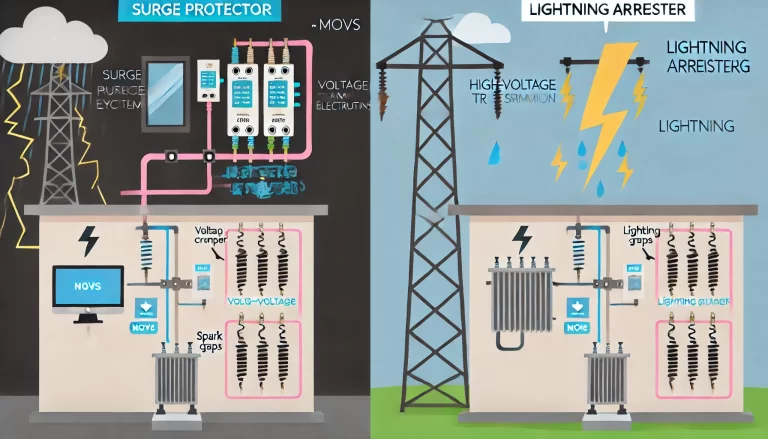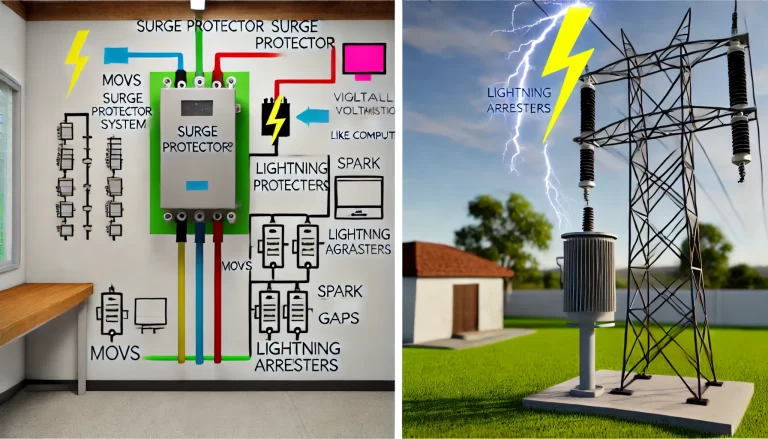Surge protectors and lightning arresters are critical components in protecting electrical systems from overvoltages and transient currents. While they may seem similar in their roles, their applications, operational principles, and targeted protections are distinct. This article delves into their differences in greater detail.
1. Definition and Primary Function
Surge Protector
- A surge protector is a device designed to shield electrical equipment from transient overvoltages caused by events such as:
- Lightning strikes (indirect impact).
- Switching operations in power systems.
- Sudden load changes or faults in nearby equipment.
- Electrostatic discharge.
- Primary Function: It limits the transient overvoltage to a safe threshold, protecting sensitive electronic devices like computers, communication systems, and industrial controllers.
Lightning Arrester
- A lightning arrester is a high-voltage protective device designed to guard against direct or induced lightning strikes.
- Primary Function: It diverts high-voltage lightning currents safely to the ground and prevents insulation breakdown of high-voltage equipment like transformers, circuit breakers, and transmission lines.

2. Working Principle
Surge Protector
- Surge protectors typically rely on voltage-limiting components such as:
- Metal Oxide Varistors (MOVs): These components act as a voltage clamp, shunting excess voltage to the ground when the voltage exceeds a predefined level.
- Gas Discharge Tubes (GDTs): These create a low-resistance path for current during a surge, effectively bypassing sensitive equipment.
- Transient Voltage Suppression (TVS) diodes: These provide precise voltage clamping and fast response times for delicate circuits.
- During a voltage spike, the surge protector momentarily absorbs or diverts the excess energy, ensuring that connected devices receive only safe voltage levels.
Lightning Arrester
- Lightning arresters consist of:
- Non-linear resistors (commonly made of zinc oxide or silicon carbide): These resistors offer high resistance during normal operation and low resistance during high-voltage events.
- Gap Mechanisms: For older types, a spark gap is used to create a conductive path when lightning-induced voltage exceeds the gap breakdown voltage.
- When a lightning strike occurs, the arrester provides a low-impedance path for the lightning current to flow to the ground, bypassing the protected equipment. Once the transient event ends, the arrester returns to its high-resistance state.
3. Voltage and Current Handling Capacity
Surge Protectors:
- Designed for low-voltage systems (e.g., household power supplies, industrial electronics).
- Typical voltage ratings: 120V, 240V, or 400V systems.
- Can handle transient currents ranging from thousands of amperes to tens of thousands of amperes.
Lightning Arresters:
- Specifically designed for high-voltage or ultra-high-voltage systems (e.g., transmission lines, substations).
- Voltage ratings: Up to 765 kV or more for power transmission networks.
- Capable of withstanding tens of thousands to hundreds of thousands of amperes of direct lightning current.

4. Applications and Installation
Surge Protector
- Applications:
- Protecting sensitive electronics and devices prone to damage from transient voltage (e.g., computers, routers, industrial controllers).
- Installed in residential, commercial, and industrial environments.
- Installation:
- Typically installed near load centers, distribution panels, or close to equipment that requires protection.
- Surge protection devices (SPDs) come in various forms, such as plug-in adapters, wall-mounted units, or integral parts of power distribution panels.
Lightning Arrester
- Applications:
- Protecting high-voltage infrastructure such as transmission lines, substations, and transformers.
- Commonly used in outdoor environments where exposure to lightning is significant.
- Installation:
- Installed at critical nodes of the power system, such as the terminal of a transformer or along transmission and distribution lines.
- Often placed at the top of electrical poles or near substations to intercept lightning strikes directly.
5. Key Differences
| Aspect | Surge Protector | Lightning Arrester |
|---|---|---|
| Primary Function | Protects equipment from transient overvoltage | Protects high-voltage systems from lightning |
| Voltage Range | Low-voltage and medium-voltage applications | High-voltage and ultra-high-voltage systems |
| Current Capacity | Handles moderate surges (thousands to tens of thousands of amperes) | Handles direct lightning currents (tens to hundreds of thousands of amperes) |
| Key Components | MOVs, GDTs, TVS diodes | Zinc oxide resistors, spark gaps |
| Placement | Close to protected devices or low-voltage panels | High-voltage poles, transformers, or substations |
| Protection Mechanism | Voltage clamping | Diverting lightning current to ground |
6. Complementary Use
While surge protectors and lightning arresters have distinct roles, they are often used in tandem for comprehensive protection. For instance:
- A lightning arrester might be installed at the transmission level to manage direct lightning strikes, while surge protectors safeguard end-user equipment from residual transient surges that penetrate deeper into the electrical system.
Conclusion
Both surge protectors and lightning arresters are indispensable in ensuring the safety and reliability of electrical systems. Understanding their unique functions, operating principles, and applications enables engineers and users to select and implement these devices effectively in various contexts. Together, they form a robust line of defense against voltage disturbances, from the grid’s highest voltages to the smallest electronic circuits.
